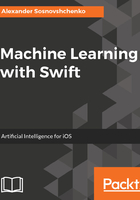
Prototyping the first machine learning app
Usually, before implementing a machine learning application for mobile devices, you want to do a quick and dirty prototype just to check your ideas. This allows to save a lot of time when you realize that the model you initially thought works perfectly for your problem, in reality doesn't. The quickest way to do a prototype is to use Python or R tools listed in the previous section.
Python is a general-purpose programming language with rich infrastructure and vibrant community. Its syntax is similar in many ways to Swift's one. Throughout this book, we'll use it for prototyping, and Swift for actual development.
When you have tested your ideas and a model prototype works as you expect, you can start thinking about how to port it to an iOS. You have several options here:
Inference-only options:
- Check the Core ML, and a list of the Python libraries it supports. Maybe, you will be able to export your model in Core ML format, and run it on a device.
- Write the custom converter for your model if it is not supported by the Core ML.
Training and inference options:
- Write the algorithms from scratch. In this book, we are implementing a bunch of machine learning algorithms, so you'll see that it's not that hard. Still, this is the most time-consuming option, and the model's results may differ significantly.
- Check available iOS-compatible libraries (see chapter on Chapter 11, Machine Learning Libraries).